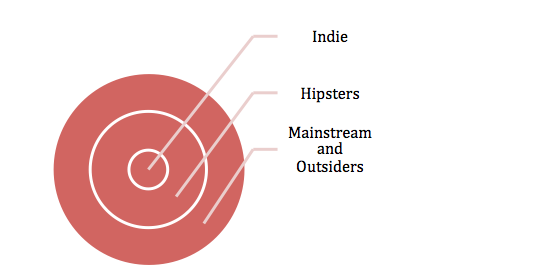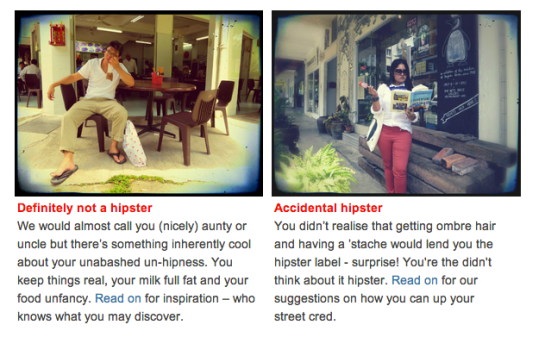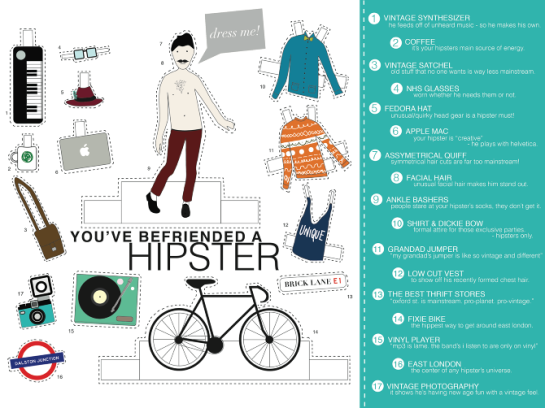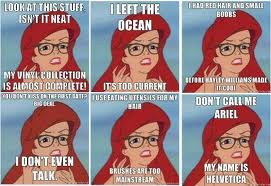We’ll be dissecting the concept of hipsters in tandem with interdisciplinary perspectives and concepts that compete with subculture today – namely that of “participatory” or “fan” cultures and “new social movements” which are the two most important cousins of subcultures. In doing so, I will be picking one of the interdisciplinary ideas mentioned to deconstruct the notion of hipsters to look at hipsters from an alternate point of view.
To summarize the concepts briefly, social movements may be seen as “groups that act with political solutions toward social problems separately from groups within subcultures, which are identified with cultural issues.” (Williams) The influence of a social movement is immense and may influence state-level decisions as well. Social movements require a collective identity as well as lifestyle politics, both of which are politically intentional. A commonality that one may draw between social movements and hipster subculture is that both feature disenfranchised groups who react with a certain extent of resistance to the dominant “system” – this is salient here as hipster consumption is intentional and goes against the mainstream grain, but is not enough to justify hipster culture as a social movement.
In contrast, the other concept of participatory culture paints a different picture which takes on an informal slant. Participatory cultures are characterized by “social networks of people with relatively low barriers to artistic expression where one finds strong support for creating culture and for sharing those creations with others, and where cultural knowledge is passed informally among members of a social network.” (Williams) In not championing a political slant, the hipster subculture fits in well here with the idea of a participatory culture. Hipster subculture as mentioned in our previous entries consist of an informal approach where the latest trends or cultural markers which denote a hipster’s cultural capital (Bourdieu) are transmitted via social networks. In short, the main intent of hipster culture is style for style’s sake which is hardly political. The main signals through which hipster culture creates meaning are through intentional stylistic features and consumption in the creation of cultural objects – a form of symbolic interactionism and pastiche.
In addition, it is mentioned that “cultural creation is not a requisite for participation, but belief in the value of amateur cultural production is.” (Williams) As such, one can theorize that the barriers to entry to participation in the hipster subculture is low, which is indeed true. Participation in the hipster subculture requires the adornment and usage of various cultural objects such as the hipster specs, fixie bike, messenger bag or oxford shoes. As long as one possesses the means for purchasing hipster cultural objects, participation is more or less guaranteed. In addition, hipster subcultural participants do not have to create their own meanings or practices, evident in the fact that they mostly follow trends and engage practices and utilize symbolic objects as touched on in our entry about hipster homology. However, ‘amateur cultural production’ is practiced which may refer to the hipster homology in which hipsters innovate on an individual level based on the homology framework given to create their own unique style that expresses their “true self” using varied commodities, or the latest ‘cultural objects’ to achieve the hipster status that they desire. One salient example of this is embodied in the image below.
In this example, the tee-shirt pokes fun at how hipsters more often than not strive within the recognized framework of musical habit to listen to the most obscure bands possible which makes them the ‘merchants of cool’ in cultivating musical tastes – linking back to ‘amateur culture production.’
In participatory movements, fans experience the same dichotomies as youth in the hipster subculture. The parallels of “consumption versus resistance” or “striving for collective difference from the mainstream while simultaneously struggling for status in a subcultural hierarchy that mimics mainstream culture” are all too familiar, in addition to tensions present.
A lack of credit for members of the participatory cultures for being active, self-reflexive consumers and the heavy investment (emotionally, culturally and economically) into a culture has challenged what the bourgeois have institutionalized as natural and universal standards of good taste, further validated in “cool hunting” by marketers who seek to commoditize trends for profit. Though regularly mocked in popular culture, stylized hipster objects have been commodified by mainstream stores – to a certain extent, one can surmise that due credit is not given to hipsters though their style has been widely perpetuated.
In evaluating the last characteristic that ties in the Hipster Subculture as a participatory culture, one should note that both hipster subculture and participatory culture carry negative connotations of the “fanatic”, where actors “act irrationally toward the object of their fandom, either as mindless consumers who will buy anything” and also “social misfits who forego the larger social world”. (Williams) Hipster subculture has more often than not been described as a ‘mindless’ pastiche of ongoing trends where hipsters who consume give little thought to the reappropriated objects that they adopt as part of their style. Also, in a show of rebellion against the mainstream, one is able to identify the hipster on the street, alluded to being the “social misfits” who “forego the larger social world” by intentionally differentiating themselves.
Lastly, I’d like to conclude this blog post with an interesting anecdotes and visual treats that I found online.
According to BubbleEWS, there exists the “hipster blogger” and “fandom blogger” on the popular site blogging Tumblr – there is an interesting dichotomy there with varying tastes but one can surmise that in essence, both hipsters and fandom-ers utilize online blogging tools as a platform to reach out to other subculturalists which further perpetuates their similarity and pervasiveness.
The Hipster Blogger
“The hipster side of this site generally consists o the people who go to coffee shops and instagram everything they do. They will generally post pictures of flowers, the sky, things that look pretty at the time or of themselves. The hipsters of Tumblr very much loathe the fandom bloggers of tumblr, but I believe it because they don’t really understand us. However, we the fandom bloggers are also to blame for this as we will never fully understand the hipsters. They post things that we as cave trolls generally don’t understand. The bright colors confuse us and we haven’t been outside in a while so we forget what flowers and trees are.”
The Fandom Blogger
“As a fandom blogger I can only really explain to you what my fandom is to the best of my abilities. Now, to start us off you have to chose and anime, tv show, movie or book that you are obsessed with. I don’t mean something that you like or something that intrigued you, I mean something that keeps you awake at night because you can’t stop thinking about the characters, plot points or the actors in these things.
For this example I will use ‘Teen Wolf’ as it is something that I blog about often. Teen Wolf, if you haven’t seen it, is a show about Werewolves…obviously. Now, the main character of Teen Wolf is Scott and he is a potato, his best friend Stiles is played by the wonderful Dylan O’Brien whom most of the fans of Teen Wolf are obsessed with. Now, I will continue this by obsessing about Stiles, because that is what i am obsessed with in Teen Wolf.”
The concluding sentence of this post is a poignant “The hipsters on the other hand, from what I understand, are obsessed with…themselves, or their image. .” which reinforces the nature of hipster subculture as discussed earlier.
And voila, we hence solemnly conclude this post with a touch of satire – a mishmash of hipster and fandom elements of blogging, combined.
(Fandom reference : Better Off Ted)
(Fandom reference : 30 Rock)
(Fandom reference : Buffy the Vampire Slayer)
(Fandom reference : How I Met Your Mother)
References
BubbleEWS. News. 2013. Retrieved 3rd November 2013 (http://www.bubblews.com/news/715392-tumblr-the-fandom-blogger-vs-the-hipster-blogger)
Tumblr. Hipster Fandom. 2013. Retrieved 3rd November 2013. (http://hipsterfandom.tumblr.com)
Williams, Patrick J. 2011. Subculture Theory. Traditions and Concepts. Polity.
Bourdieu, P. 198. The forms of capital. In J. Richardson (Ed.) Handbook of Theory and Research for the Sociology of Education. New York, Greenwood. 241-258.
























 Hipster racism happens when one intentionally adopts and trivializes aspects of a race different from her/his own in the name of harmless fun, or to If American Apparel is guilty of nefarious hipster sexism, then it’s counterpart in hipster fashion is equally guilty in hipster racism.
Hipster racism happens when one intentionally adopts and trivializes aspects of a race different from her/his own in the name of harmless fun, or to If American Apparel is guilty of nefarious hipster sexism, then it’s counterpart in hipster fashion is equally guilty in hipster racism.




